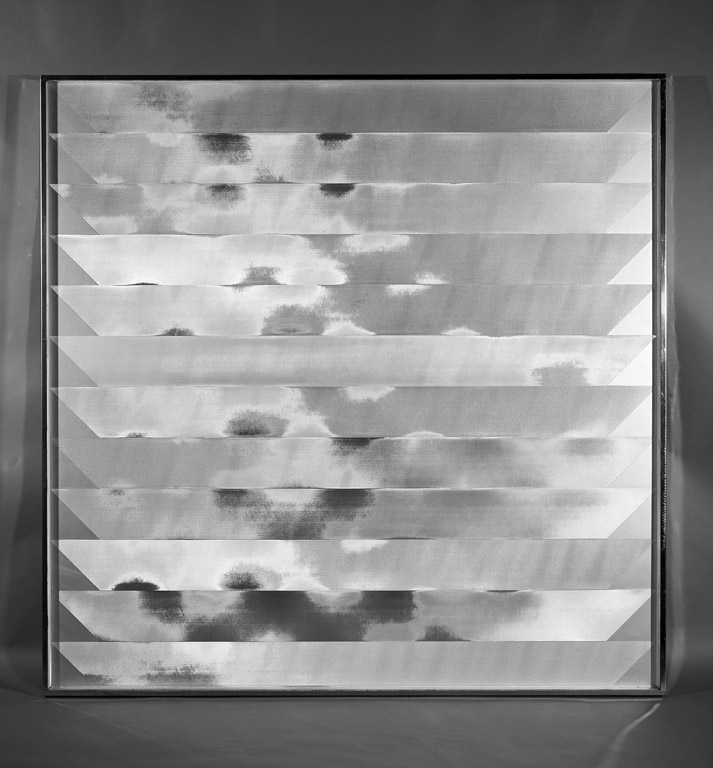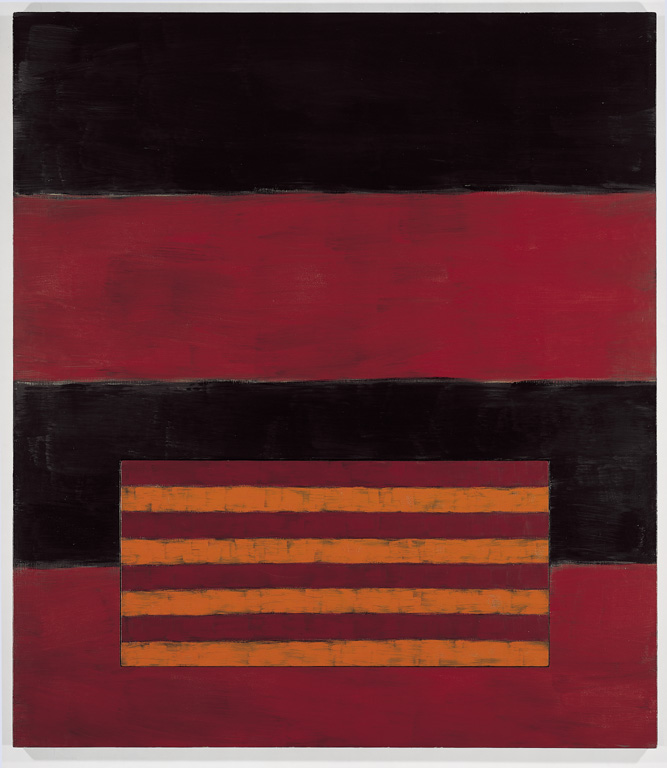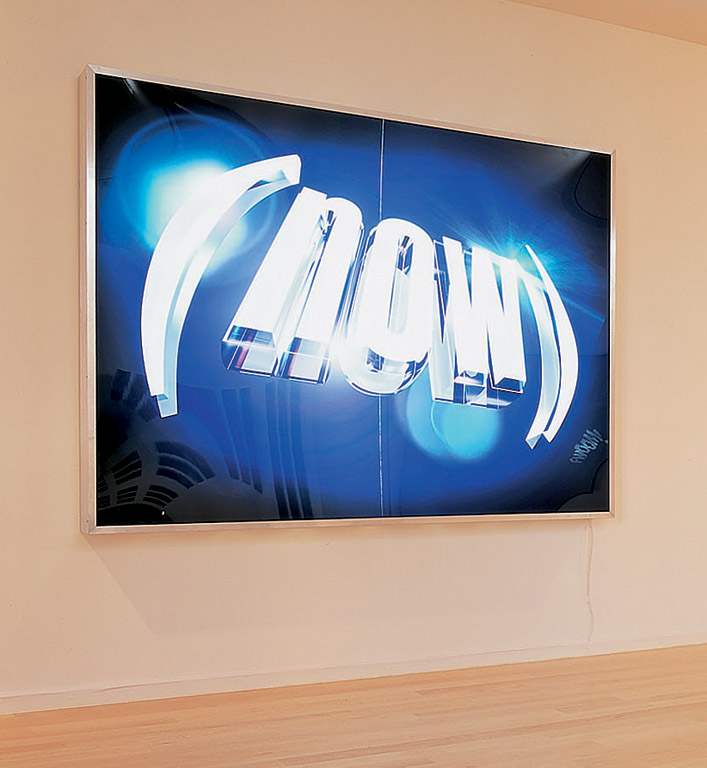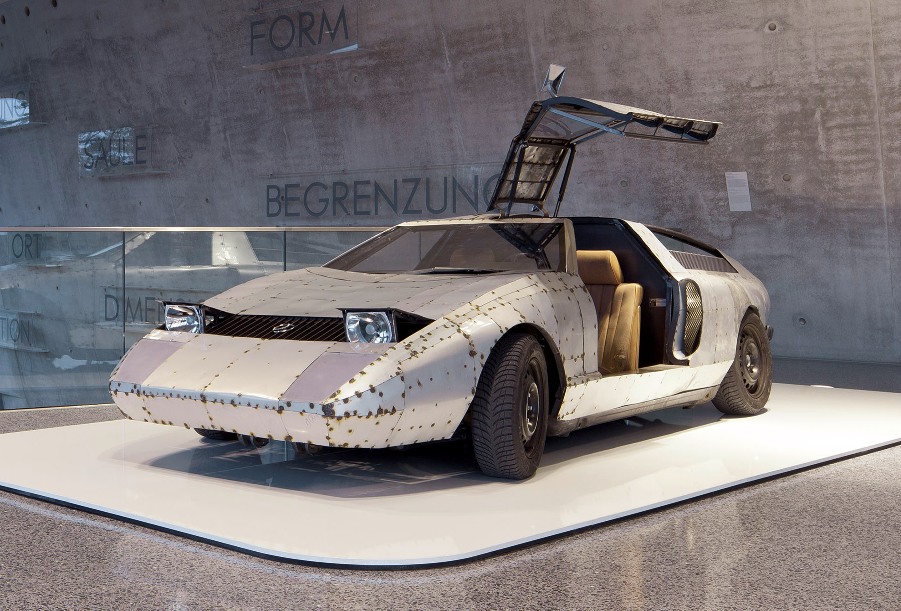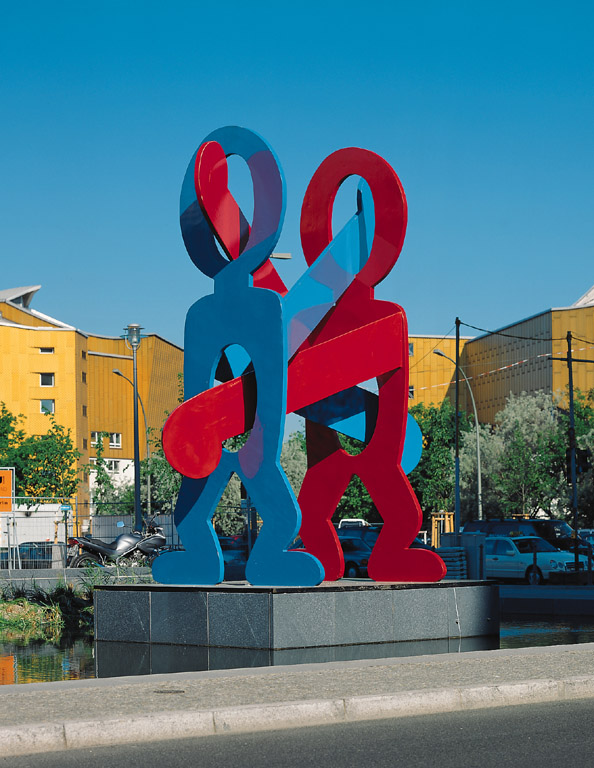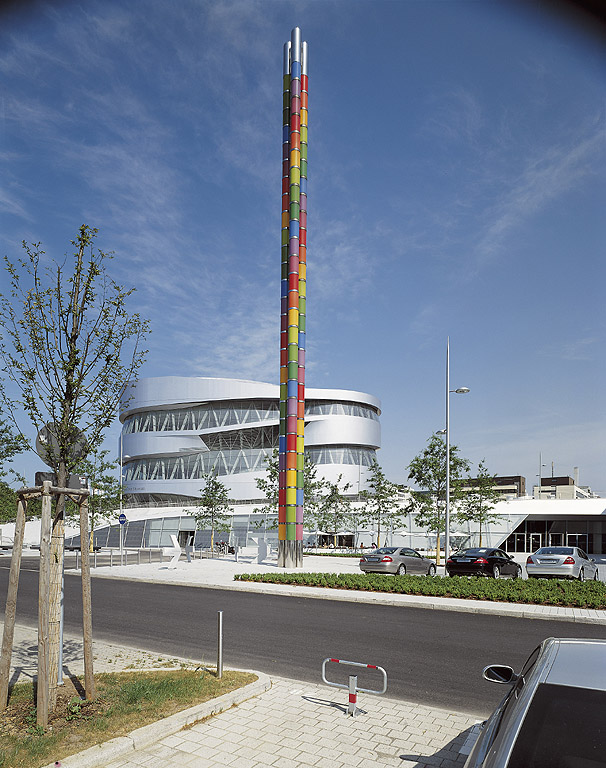Focal Points
The collection profile of the Mercedes-Benz Art Collection focuses on the abstract avant-gardes of the 20th century and international contemporary art. It concentrates on abstract-constructive pictorial concepts, critical-engaged art as well as representative works and commissioned works on topics such as automobility, design or construction. The spectrum of media ranges from painting, drawing, sculpture, object and light art to installation, photography and video.
Classical Modernism – Constructivism and Concrete Art

Josef Albers, Study for Homage to the Square: ›Opalescent‹, 1962
The works of Classical Modernism in the Mercedes-Benz Art Collection primarily comprise painting, but also sculpture, wall objects and graphic art. They illustrate the development of art up to the 1960s with a focus on South-West Germany. These include the Stuttgart avant-garde (from Hölzel to Bauhaus) and the concrete artists (the Ulm Hochschule für Gestaltung, the Zurich Concrete Artists, links with De Stijl). Two compositions by Adolf Hölzel from around 1910 form the chronological starting-point of this strand of the collection. Hölzel, who was appointed to the Stuttgart Academy in 1905, taught Willi Baumeister, Camille Graeser, Otto Meyer-Amden, Oskar Schlemmer, Ida Kerkovius, Johannes Itten and Maria Lemmé, among others. They are each featured in the collection with representative work groups or key single works. Schlemmer, who is of particular importance within the Mercedes-Benz Art Collection with eight works from three decades, worked as a teacher at the Bauhaus in Weimar and Dessau from 1921 to 1928.
Josef Albers, whose biography was also shaped by his studies and teaching at the Bauhaus, emigrated to the USA in 1933, where he became one of the leading figures in education. Three works in the collection illustrate the important stages of the development during his time there. Max Bill is another key artist in the Mercedes-Benz Art Collection. He studied at the Dessau Bauhaus under Schlemmer, Kandinsky and Klee, and was co-founder and first director of the Hochschule für Gestaltung in Ulm in 1950. Bill became a member of the abstraction—création group, founded in Paris in 1931, which also included, among others, the artists Arp, Baumeister and Vantongerloo, who also feature in the collection. In the 1930s, Bill, together with Camille Graeser, Verena Loewensberg and Richard Paul Lohse, was one of the core members of the Zurich Concrete Artists, whose spokesman and theoretical head Bill remained until the 1960s. Friedrich Vordemberge-Gildewart— a member of De Stijl, briefly a student at the Bauhaus in Weimar and Dessau, co-founder of die abstrakten hannover, friend of Bill and later a teacher at the Academy in Ulm—is connected with all these circles and can be seen as the most important pioneer of Concrete Art in Germany.
Art Informel, Representational Painting, The Karlsruhe School
The tendencies of Art Informal are represented in the Mercedes-Benz Art Collection by artists such as Bernd Berner, Peter Brüning, Karl Fred Dahmen, Gerhard Hoehme, Horst Kuhnert, Uwe Lausen, Georg Meistermann, Fred Thieler and Fritz Winter. The gestural developments of the movement are visible in the works of Stuttgart painters Rudolf Schoofs and K.R.H. Sonderborg. Figurative painting, which can be seen as a counter-movement to Art Informel, includes the works of Stuttgart-based Leonhard Schmidt, Manfred Pahl, Lambert Maria Wintersberger and Ben Willikens. The figurative-expressive Karlsruhe School with its ‘father figure’ HAP Grieshaber and his students Horst Antes, Dieter Krieg and Walter Stöhrer can also be categorised in this line of development.
The Stuttgart School
Based on Art Informel, a group of young artists emerged in the early 1960s who developed large-scale colour field painting that disrupted the traditional picture format in an object-like manner and sought a connection to architecture and urban planning. Among them were Otto Herbert Hajek, Georg Karl Pfahler, Thomas Lenk and Lothar Quinte. Their works, along with those of their American contemporaries, were brought together in an epochal exhibition at the Württembergischer Kunstverein Stuttgart in 1967 under the title Formen der Farbe (Forms of Color).
ZERO
ZERO and the New Tendencies as European movements in the transition to Minimalism are represented in the Mercedes-Benz Art Collection by names such as Enrico Castellani, Getulio Alviani, Dadamaino, Gerhard von Graevenitz, Jan Henderikse, Heinz Mack, Almir Mavignier, François Morellet, Jan Schoonhoven or Klaus Staudt. Singular positions within this spectrum, which touch on various trends and at the same time reject them, are Rupprecht Geiger, Günter Fruhtrunk and Herman de Vries. They are represented in the collection with notable work groups that offer distinctive accents.
Minimalism in Europe and the USA
The most important abstract movements of the 1950s to 1970s are characterised by a return to the origins of concrete, constructivist and minimalist art and their further development, albeit each with their own particular emphases in Europe and America. The combination of European structural-constructive painting with US-american tendencies – such as minimal art, colour field painting, hard-edge painting or op art – can be seen in the Mercedes-Benz Art Collection with works by artists such as Adolf Fleischmann, Hartmut Böhm, Andreas Brandt, Ulrich Erben, Gottfried Honegger, Karl Gerstner, Manfred Mohr, and Anton Stankowski.
Outstanding positions of European minimalist art from the 1960s are represented by the works of Peter Roehr, Charlotte Posenenske, Hanne Darboven, Eckhard Schene, Franz Erhard Walther and Ulrich Rückriem. With Henryk Stazewski, Poul Gernes, Tadaaki Kuwayama, Keiji Usami, Arakawa+Gins and Albert Mertz, important artists of minimalist painting from Scandinavia, Eastern Europe and Japan are now also featured. Precursors of a European minimalism in the Mercedes-Benz Art Collection can be found in the works of Josef Albers, Hermann Glöckner, Richard Paul Lohse, or Friedrich Vordemberge-Gildewart. An important reference work for reductionist painting in the United States is a 1969 painting by Robert Ryman. Parallel to this focus, the collection is dedicated to the precursors and early representatives of American minimalist painting – who have remained virtually unknown in Europe – with acquisitions by Gene Davis, John McLaughlin, David Novros, Jo Baer, Karl Benjamin, Ilya Bolotowsky, Marcia Hafif, Frederick Hammersley, Oli Sihvonen, Alexander Liberman, Larry Zox and Mary Corse. British positions from the 1960s have been supplemented names such as Jeremy Moon, Robyn Denny and Michael Kidner. These form the basis of more recent positions in the collection, such as Jens Wolf, Greg Bogin, Michael Zahn, Martin Gerwers, Martin Boyce and Natalia Stachon.
Abstract, Conceptual and Medial Tendencies in Contemporary Art
The early focal points of the Mercedes-Benz Art Collection – the reduced, constructivist-concrete and minimalist direction of 20th century art – have been expanded since the 1990s to include works by the generation of artists born in 1945/1950. These include Ulrich Erben, Alfons Lachauer, Christa Näher, Günter Scharein, Artur Stoll, Ford Beckman, Dieter Villinger, Sean Scully and Yuko Shiraishi.
The arc from the non-representational positions of post-war modernism to the multimedia field of contemporary art, in the collection, is essentially spanned by a group of artists born between 1930–45: John M Armleder, Charlotte Posenenske, Nam June Paik, Walter De Maria, Ulrich Rückriem, Auke de Vries, Daniel Buren, Roman Signer, Franz Erhard Walther, Imi Knoebel, Hanne Darboven, Bernar Venet, Olivier Mosset, Michael Heizer, Giulio Paolini, Peter Roehr, and Joseph Kosuth. They all work towards a new definition of the concept of the artwork and override traditional genre boundaries. At the same time, they incorporate the mental and/or physical activity of the viewer into the work process and understand the image in its broadest definition as a viable conceptualization of the present. Gia Edzgveradze, Günther Förg and Bertrand Lavier are to be mentioned in this context.
The work of artists in the collection such as John M Armleder, Gerwald Rockenschaub, Peter Halley and Andrea Zittel is fed by the tireless discourse on the concept of the image in the 20th century. In neo-geo images, objects, sculptures as well as poster and video works, these artists review the stylistic canon of modernism, enriched by the views of the Pop and Fluxus generations, and reveal it in its historical and ideological determinations.
Since the 1990s, tendencies of minimalism and conceptual art have been taken further in the works of Andrea Fraser, Karin Sander, Krysten Cunningham, Martin Gerwers, Gail Hastings, Greg Bogin, Andreas Schmid, Michael Zahn, Gerold Miller, Sylvan Lionni, Martin Boyce, George Henry Longly, Rupert Norfolk, Monika Sosnowska, Natalia Stachon, Leonor Antunes, Eva Berendes, and Alicja Kwade. The transition from traditional panel painting to wall-based objects, as well as the dissolution of genre boundaries are thematised in the works of Sylvie Fleury, Bernhard Kahrmann, Monika Brandmeier, Nikolaus Koliusis, Mathieu Mercier, Alf Schuler, Beate Terfloth, Tobias Hauser, Silke Radenhausen, Eva Maria Reiner, Madeleine Boschan, and Saâdane Afif.
Pietro Sanguineti, Markus Huemer, Isabell Heimerdinger, Takehito Koganezawa, Tacita Dean, Albert Weis, Katja Davar, Philippe Parreno, Marcellvs L, Shilpa Gupta, Berni Searle, Sharif Waked, Maya Zack, Ilit Azoulay and Sigalit Landau conduct substantial research into new visual media. Conceptual tendencies from around 1970 to the present have found their way into the collection with works by Dan Graham, Michel Verjux, Heimo Zobernig, Sol LeWitt, Danica Phelps, Karin Sander, Jonathan Monk, Lasse Schmidt Hansen, Andreas Reiter Raabe or Wolfgang Berkowski.
Commissioned Works
Part of the collection consists of commissioned works that relate to the product ‘automobile’ or to the collection’s sculptures and murals. Groundbreaking, not least of all for the early international orienting of the collection, was the commissioning of Andy Warhol in 1986 to create works on the occasion of the 100th anniversary of the automobile. A second commission went to the New York artist Robert Longo, who created a series of five black and white automotive “portraits”. Since the 1980s, commissions for site-specific works have gone to Max Bill, Heinz Mack, François Morellet, Walter De Maria, Ben Willikens, Tamara K.E., Gerold Miller, Pietro Sanguineti, Franz Erhard Walther, Peter Halley, Jan van der Ploeg, Patricia London Ante Paris, Martin Gerwers, Andreas Schmid, Andreas Reiter Raabe, Stéphane Dafflon and others.
The Stuttgart artist Simone Westerwinter created a portrait of the company in 2001 in the form of 60 watercolors of names and car models. Since then, numerous other commissioned works have been realized: Sylvie Fleury created six video films for the Mercedes-Benz Center Paris in 2006. On the occasion of the 125th birthday of the automobile in 2011, the Swiss artist Nic Hess, together with the Mercedes-Benz Design Department, created a room-sized installation for the gallery of “Silver Arrows and racing cars” in the Mercedes-Benz Museum in Stuttgart. Michael Sailstorfer reflected on the design practice of “morphing” by using collage techniques to convert a Mercedes-Benz 190E (W201) into a road-ready interpretation of the legendary Mercedes-Benz C 111 research vehicle. In 2011, the artist Philippe Parreno created the film CHZ (as a cooperation between the Mercedes-Benz Art Collection and the Fondation Beyeler, Basel) as a combination of real, temporary natural processes with cinematic fiction and staging.
Sculptures
Around 1989, Mercedes-Benz acquired a group of eleven large sculptures for the Stuttgart-Untertürkheim site and for the public and outdoor areas of the company’s then headquarters in Stuttgart-Möhringen. These included central works by Walter De Maria, Norbert Kricke, Max Bill, Heinz Mack or Klaus Staudt. This was the beginning of a comprehensive collection of large sculptures that are linked to the identity of the company.
Sculptures in Berlin
Parallel to the construction of Potsdamer Platz, eight international artists were selected between 1995 and 2002, from each of whom an existing sculpture was acquired or a site-specific work was commissioned. The sculptures by Keith Haring, Robert Rauschenberg, Mark di Suvero, Nam June Paik, Jean Tinguely, François Morellet, Frank Stella and Auke de Vries provided a much-noticed urban accent in the centre of Berlin for many years. With the sale of the site in 2008 and the conversion of the space, the Mercedes-Benz Art Collection temporarily stored some of the sculptures or transferred them to new locations.
Sculptures in Stuttgart und Sindelfingen
Max Bill’s bildsäulen – dreiergruppe from 1989 in front of the Mercedes-Benz Museum connects the grounds of the Stuttgart-Untertürkheim plant and the urban surroundings with its height of 32 metres. Within sight of this is the sculpture Tag und Nacht, 1983, by Bernhard Heiliger. The sculpture combines a geometric-technical formal language with nature-like elements. It is dedicated to the memory of those forced into labor by the Nazis during World War II. Associations with a naturalistic language also define the monumental bronze sculpture Taurus (Early Forms), 1999, by Tony Cragg, which binds basic molecular and geological elements into the form of a knot-like body.
The granite sculpture Bleu de Vivre, 1986, by Ulrich Rückriem seems to have grown like a tree in its natural environment. In 2018, this group of works was supplemented by two further pieces: a dynamic sculpture by Frank Stella, Prince Frederick Arthur of Homburg, General of Cavalry, 1999, and the geometric, ring-shaped interlocking steel elements of Nigel Hall’s Big River, 1998, now connect the towering, vertical building structure of the new executive building in Untertürkheim with the horizontal movements of pedestrians and vehicles. Franz Erhard Walther’s wall piece Wortfeld, 2005, was commissioned for the entrance area of the Mercedes-Benz Museum, itself designed by UNStudio Van Berkel & Bos of Amsterdam. Deeper inside, visitors find the large relief combillation aus 30 gleichen elementen in 6 gruppen, 1986, and doppelfläche mit sechs rechtwinkligen ecken, 1948–78, a Möbius strip sculpture, both by Max Bill, a monumental photographic panorama by Walter Niedermayr and murals by Jan van der Ploeg.
For the spacious grounds of the Mercedes-Benz Sindelfingen plant near Stuttgart, where the final assembly of many types of vehicles takes place, large works have been acquired since the mid-1990s. These aesthetically focus the open architectural structure at various points. The airy, space-creating sculpture Die Fließende, 1972, by Norbert Kricke stands outdoors like a natural monument; Gerold Miller’s mural Plan 3 for the Centre of Excellence, inaugurated in 2002, transposes abstract modernist trends into the 21st century; Julian Schnabel’s bronze sculpture Queequeg, 2010, derives its name from the character of the harpooner in Herman Melville’s novel Moby Dick (1854).
Integration of Women Artists
The Mercedes-Benz Art Collection places a strategic emphasis on the ongoing establishment and promotion of women in art: as of 2022, women artists make up about a third of the collection. Important individual works or groups of works by representatives of the international post-war avant-gardes and contemporary art have found their way into the collection. In the early 2000s, these included Dadamaino, Sylvie Fleury, Gail Hastings, Isabell Heimerdinger, Tamara K.E., Sarah Morris, Charlotte Posenenske, Elaine Sturtevant, Simone Westerwinter or Andrea Zittel. From 2003 on, works by other internationally renowned artists such as Jane Alexander, Leonor Antunes, Jo Baer, Hanne Darboven, Ulrike Flaig, Andrea Fraser, Beate Günther, Silke Radenhausen, Berni Searle, Pamela Singh or Katja Strunz followed. More recently, works by, for example, Bethan Huws, Cao Fei, Iman Issa or Haris Epaminonda have been added along with many others.
Recent Focal Points
The Mercedes-Benz Art Collection is strongly committed to diversity. Its collecting practice is resolutely geared towards promoting international artists and the diversity of cultures, orientations, and views. Between 2000 and 2010, exemplary works and groups of works by artists from Australia (John Nixon, Gail Hastings, Ian Burn, and others), Asia, South Africa, India, and the United States were added to the collection. In 2012, contemporary Israeli artists were added to the Mercedes-Benz Art Collection, including Ilit Azoulay, Sigalit Landau, Sharif Waked and Amit Berlowitz, who complement the collection in the areas of video art and photography. A group of works by Scottish conceptual artist and 2011 Turner Prize winner Martin Boyce was acquired for the Conceptual Tendencies exhibition. Works by French artist Michel Verjux and Philippe Parreno, originally from Algeria, also expand the collection in the conceptual field. With Natalia Stachon, Alicja Kwade, and Monika Sosnowska, contemporary Polish women artists are also represented.
Contemporary Art from China
One focus of the acquisition policy in 2014/2015 was Chinese contemporary art. Since then, around 40 works by around 20 Chinese artists have added an important aspect to the collection. The impetus for this new collecting focus arose from the consistent and long-term internationalization of the collection. Chinese contemporary art began as an independent development in the mid-1980s, which is reflected in the acquisition of a work by Zhang Peili, a pioneer of conceptual and video art in China. Brown Book No.1, 1988, is the documentation of one of Peili’s early mail art projects.
Other already established artists from whom works from the period around 1990 to 2010 were acquired include Qiu Zhijie, Cao Fei, Yin Xiuzhen, Liu Zheng, and Ding Yi. The acquisitions focus on contemporary young art from Beijing, Shanghai, Hangzhou and Guangdong (including Hong Kong), as well as artists born around 1980—85.
Art as Network: Research and Exhibitions Concerning the Historical and Contemporary Readymade
In 2016, the Mercedes-Benz Art Collection, together with Marcel Duchamp expert Katharina Neuburger, initiated research for a symposium and publication of the Mercedes Art Collection. Under the theme Duchamp as Curator, Duchamp’s curatorial activities were brought into focus and their relevance to his artistic work examined. From this and further extensive research, a series of exhibitions and publications of the Art Collection have been developed.
Artists of the African Diaspora
Since 2019, the Mercedes-Benz Art Collection has been exploring the movement of Afrofuturism. At the centre of this movement, which is particularly influential for the African diaspora in the United States, is a return to the cultural traditions of Black people. Related to this is the movement of Africanfuturism which emerged around 2013. This latter movement focusses on the indissoluble connection between Black people living on the continent and in the diaspora. It focusses specifically on cultural, literary, artistic and political traditions that have developed in Africa. The movement is supported in particular by people with African roots. They are driven by a strong desire to intervene in the shaping of the future from the knowledge of their own point of view and from their cultural roots. Africanfuturism lends to this dynamic, strong and positive perspective musical, literary and artistic images and formulates new scientific, philosophical, technical and economic orientations.
The Mercedes-Benz Art Collection has accompanied these recent cultural developments via its cooperation with and inclusion of artists of Black African origin, some of whom live on the continent and others in the diaspora: Mbali Dhlamini, Nnenna Okore, Berni Searle, Lerato Shadi, Buhlebezwe Siwani, Adejoke Tugbiyele and Kayode Ojo. They all address aspects of transculturality, social and political reconceptualisation, postcolonialism, feminism, and a contemporary perspective on identity politics and gender constructions. The work and position of Zanele Muholi, who is featured in the Mercedes-Benz Art Collection with four works, presents an exemplary articulation of Africanfuturism. Muholi’s self-portraits and portraits of the people surrounding them show the physiognomies and charisma of a young, queer generation, in works which self-confidently integrate references to recent history and critical reflection on the “now” into a self-image with an open perspective.

